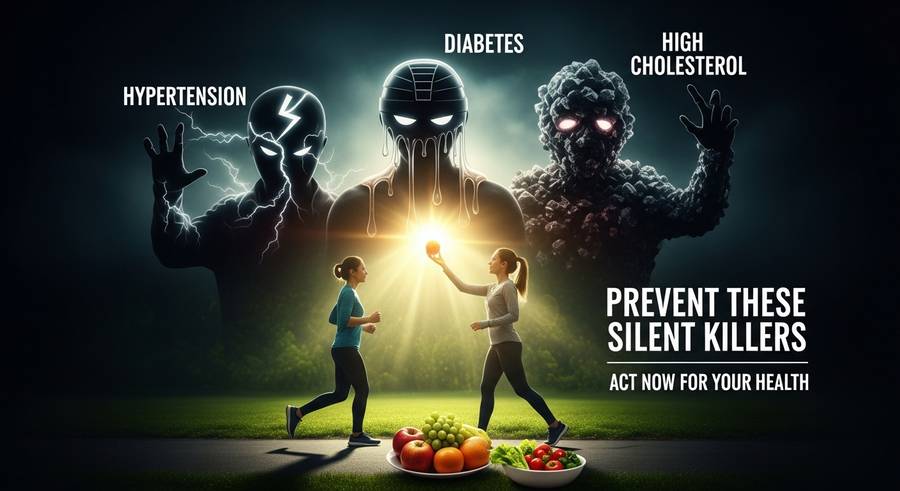
Killer 1 High Blood Pressure (Hypertension)
High blood pressure, also known as hypertension, is often called the "silent killer" because it typically has no symptoms. Over time, untreated high blood pressure can lead to serious health problems.
- What it is: Blood pressure is the force of blood pushing against the walls of your arteries. Hypertension means this force is consistently too high.
- Risks: It significantly increases the risk of heart disease, stroke, kidney failure, and other health issues.
- Management:
- Regular Check-ups: Get your blood pressure checked regularly by a healthcare professional.
- Healthy Diet: Reduce sodium intake, eat plenty of fruits and vegetables, and choose lean proteins.
- Regular Exercise: Aim for at least 150 minutes of moderate-intensity aerobic activity per week.
- Maintain a Healthy Weight: Losing even a small amount of weight can help lower blood pressure.
- Limit Alcohol: Consume alcohol in moderation, if at all.
- Quit Smoking: Smoking damages blood vessels and raises blood pressure.
- Manage Stress: Find healthy ways to cope with stress.
- Medication: If lifestyle changes are not enough, your doctor may prescribe medication.
-
Pressure Readings
What is Standard Blood Pressure?
Standard blood pressure is typically considered to be within a healthy range. Blood pressure is measured in millimeters of mercury (mm Hg) and is given as two numbers:
Systolic pressure (the top number): This measures the pressure in your arteries when your heart beats.
Diastolic pressure (the bottom number): This measures the pressure in your arteries when your heart rests between beats.
A normal blood pressure reading is generally considered to be less than 120/80 mm Hg.
When is Blood Pressure Considered High?
Blood pressure is considered high (hypertension) when it consistently measures at or above certain thresholds. The American Heart Association and the American College of Cardiology have established guidelines for blood pressure categories:
Elevated Blood Pressure: Systolic between 120-129 mm Hg AND diastolic less than 80 mm Hg. People in this category have a higher risk of developing high blood pressure.
Stage 1 Hypertension: Systolic between 130-139 mm Hg OR diastolic between 80-89 mm Hg.
Stage 2 Hypertension: Systolic 140 mm Hg or higher OR diastolic 90 mm Hg or higher.
Hypertensive Crisis: Systolic higher than 180 mm Hg and/or diastolic higher than 120 mm Hg. This requires immediate medical attention.
It is important to note:
A single high reading does not necessarily mean you have hypertension. Blood pressure can fluctuate throughout the day due to stress, activity, or other factors.
Diagnosis of hypertension is usually made based on multiple readings taken over time by a healthcare professional.
If you have any concerns about your blood pressure, it is crucial to consult with your doctor. They can provide an accurate diagnosis and recommend the best course of action for your individual health.
Killer 2 High Blood Sugar (Diabetes Mellitus)
High blood sugar, a hallmark of diabetes, can also go unnoticed for years, silently damaging organs and systems. There are two main types: Type 1 (autoimmune) and Type 2 (often lifestyle-related).
- What it is: Diabetes occurs when your body either doesn't produce enough insulin or can't effectively use the insulin it produces. Insulin is a hormone that regulates blood sugar.
- Risks: Uncontrolled high blood sugar can lead to nerve damage, kidney disease, eye problems (including blindness), heart disease, stroke, and foot problems that can result in amputation.
- Management:
- Screening: Get screened for diabetes, especially if you have risk factors (family history, obesity, inactivity, etc.).
- Balanced Diet: Focus on whole grains, lean proteins, and healthy fats. Limit sugary drinks and processed foods.
- Regular Physical Activity: Exercise helps your body use insulin more effectively.
- Weight Management: Achieving and maintaining a healthy weight is crucial for managing blood sugar.
- Blood Sugar Monitoring: Regularly check your blood sugar levels as advised by your doctor.
- Medication/Insulin: Depending on the type and severity, medication or insulin therapy may be necessary.
-
What are Good Blood Sugar Readings?
"Good" blood sugar readings depend on whether a person has diabetes, prediabetes, or no known blood sugar issues, and also on the timing of the reading (e.g., before a meal, after a meal). However, there are general target ranges often recommended by healthcare professionals for individuals diagnosed with diabetes.
For people with diabetes, general target ranges for blood glucose are often:
Before a meal: 80 to 130 mg/dL (milligrams per deciliter).
1 to 2 hours after the start of a meal: Less than 180 mg/dL.
These are general guidelines, and an individual's specific targets may vary based on their age, overall health, presence of other medical conditions, and doctor's recommendations.
What are Bad Blood Sugar Readings?
"Bad" blood sugar readings are those that are consistently too high (hyperglycemia) or too low (hypoglycemia), as these can lead to short-term symptoms and long-term health complications.
Readings indicating hyperglycemia (too high blood sugar):
Consistently above target ranges: Readings that frequently exceed 130 mg/dL before meals or 180 mg/dL after meals can be considered problematic over time.
Very high readings: Readings of 240 mg/dL or higher are generally considered high and require attention. Prolonged very high blood sugar can lead to serious complications like diabetic ketoacidosis (DKA) in Type 1 diabetes or hyperosmolar hyperglycemic state (HHS) in Type 2 diabetes.
Readings indicating hypoglycemia (too low blood sugar):
Below 70 mg/dL: This is generally considered the threshold for hypoglycemia and requires immediate action.
Severely low readings: Readings significantly below 54 mg/dL may be considered severe hypoglycemia and can lead to confusion, seizures, or loss of consciousness.
It is crucial to remember:
These ranges are general. Your doctor will provide you with personalized target ranges and guidance based on your specific health profile and diabetes management plan.
Regular monitoring of blood sugar levels is key to understanding your patterns and making necessary adjustments to diet, exercise, or medication.
If you experience readings that are consistently too high or too low, or if you have symptoms associated with them (e.g., excessive thirst, frequent urination, extreme hunger, dizziness, confusion, sweating), you should consult your healthcare provider immediately.
Killer 3 High Cholesterol (Hyperlipidemia)
High cholesterol, particularly high levels of LDL (low-density lipoprotein) cholesterol, is another silent threat. It doesn't cause immediate symptoms but contributes to the buildup of plaque in arteries.
- What it is: Cholesterol is a waxy substance your body needs, but too much, especially "bad" LDL cholesterol, can be harmful. High triglycerides are also a concern.
- Risks: Plaque buildup (atherosclerosis) narrows arteries, restricting blood flow. This dramatically increases the risk of heart attack and stroke.
- Management:
- Blood Tests: Regular cholesterol screenings are essential to know your levels.
- Dietary Changes: Reduce saturated and trans fats, limit red meat and full-fat dairy, and increase intake of soluble fiber (oats, beans, fruits) and healthy fats (avocados, nuts, olive oil).
- Exercise: Aerobic exercise can help raise HDL ("good" cholesterol) and lower LDL and triglycerides.
- Weight Management: Losing excess weight can improve cholesterol levels.
- Quit Smoking: Smoking negatively impacts cholesterol levels and damages blood vessels.
- Medication: If lifestyle changes are insufficient, statins and other medications are often prescribed to lower cholesterol.
Low-density lipoprotein (LDL): Often called "bad" cholesterol, LDL cholesterol builds up in the walls of arteries, making them hard and narrow.
High-density lipoprotein (HDL): Often called "good" cholesterol, HDL cholesterol picks up excess cholesterol and takes it back to the liver.
Triglycerides: These are a type of fat in your blood. High levels of triglycerides, combined with low HDL or high LDL cholesterol, can increase your risk of heart disease.
What are Good Cholesterol Readings?
A "good" cholesterol profile generally means having low levels of LDL cholesterol and high levels of HDL cholesterol, along with healthy triglyceride levels.
For most adults, desirable levels are:
Total Cholesterol: Less than 200 mg/dL (milligrams per deciliter). This is a combination of LDL, HDL, and other lipid components.
LDL ("Bad") Cholesterol: Less than 100 mg/dL. For people at very high risk of heart disease, doctors may recommend levels below 70 mg/dL.
HDL ("Good") Cholesterol: 60 mg/dL or higher. Higher HDL levels are protective.
What are Bad Cholesterol Readings?
"Bad" cholesterol readings are those that indicate an increased risk of heart disease, stroke, and other cardiovascular problems.
Total Cholesterol: 240 mg/dL or higher is considered borderline high to high.
LDL ("Bad") Cholesterol: 100 mg/dL to 139 mg/dL is considered borderline high for many people. Levels of 130 mg/dL to 159 mg/dL are considered high, and 160 mg/dL or higher is considered very high.
HDL ("Good") Cholesterol: Levels less than 40 mg/dL for men and less than 50 mg/dL for women are considered low and increase the risk of heart disease.
Triglycerides: Levels 150 mg/dL to 199 mg/dL are considered borderline high. Levels 200 mg/dL to 499 mg/dL are considered high, and 500 mg/dL or higher are considered very high.
Important Considerations:
These are general guidelines. Your doctor will interpret your cholesterol results in the context of your overall health, family history, age, sex, and other risk factors for heart disease.
A lipid panel, which measures all these components, is typically performed during a regular physical examination.
If your cholesterol levels are high or borderline high, your doctor will discuss lifestyle changes and possibly medication to help manage them.
The Critical Importance of Monitoring and Controlling Health Markers
Why Keeping Track is Essential
Monitoring and controlling key health indicators like blood pressure, blood sugar, and cholesterol is not just a recommendation; it's a fundamental aspect of maintaining long-term health and preventing serious illness. These three markers are often referred to as "silent killers" precisely because they can reach dangerous levels without causing noticeable symptoms until significant damage has already occurred.
 Preventing Severe Health Consequences
Preventing Severe Health Consequences
Cardiovascular Disease: Uncontrolled high blood pressure, high cholesterol, and high blood sugar are major risk factors for heart disease, heart attack, stroke, and peripheral artery disease. These conditions are leading causes of death and disability worldwide. Keeping these numbers in check significantly reduces your risk.
Kidney Disease: High blood pressure and high blood sugar can damage the delicate blood vessels in your kidneys, leading to chronic kidney disease and eventual kidney failure.
Vision Loss: Diabetes is a leading cause of blindness. Consistently high blood sugar levels can damage the blood vessels in your eyes, leading to diabetic retinopathy.
Nerve Damage: High blood sugar can damage nerves throughout your body, causing neuropathy. This can lead to pain, numbness, and problems with digestion, circulation, and other bodily functions.
Amputations: Poorly managed diabetes can lead to nerve damage and poor circulation in the feet, which can result in infections and necessitate amputations.
Improving Quality of Life
Energy Levels and Well-being: When these health markers are out of balance, it can affect your overall energy levels, mood, and general sense of well-being. Controlling them often leads to feeling better physically and mentally.
Longevity and Independence: By preventing chronic diseases and their complications, you increase your chances of living a longer, healthier, and more independent life. This means being able to enjoy activities, travel, and spend time with loved ones without being limited by illness.
Cost-Effectiveness
Reduced Healthcare Costs: Preventing serious chronic diseases is far more cost-effective than treating them. Managing these numbers through lifestyle changes and, if necessary, medication can save you significant medical expenses in the long run, including hospitalizations, surgeries, and long-term care.
Taking Control of Your Health
Empowerment: Regularly monitoring your health markers empowers you to take an active role in your well-being. It allows you to make informed decisions about your diet, exercise, stress management, and when to seek medical advice.
Early Intervention: Identifying issues early, even before symptoms appear, allows for timely intervention. This often means that less aggressive treatments are needed, and the chances of successful management are much higher.
In summary, keeping track of and controlling your blood pressure, blood sugar, and cholesterol levels is paramount. It is a proactive approach to safeguarding your health, preventing debilitating diseases, and ensuring a better quality of life for years to come. Regular check-ups with your doctor and adherence to their recommendations are vital steps in this ongoing process.
Connect with Us
Follow this page for updates, wellness tips, and more information about our Products. Share your experiences and join our community!
You can order the Products directly from a certified APLGO distributor or via
E-mail me at Mfrost9345@yahoo.com
Want to Share Wellness & Earn?
You Can Become A Bussiness Associate — earning income while helping others feel better too.
Get product discounts
Earn commissions from referrals
Grow a wellness business with a purpose
It’s more than just joint relief. It’s an opportunity.
Call to Action
Try Our Products today —
Message now for guidance, specials, or to place your order.
Know someone who would love this? Share this blog with them — they’ll thank you.
🛒Place your order here as customer
Text for more info: 1-443-907-0033
Back to Table of Contents
Botanical Products Reviewed by Nutritional Physiologist Mary Esther Gilbert
Insights from the BusinessforHome Press Release
Scan QR Code to Become a Business Owner for $25

ADVERTISEMENT

The silent killers you don't see could be costing you your health
Acumullit SA® technology harnesses the power of nature to create highly bioavailable nutrient drops. These drops deliver targeted benefits to support your body's natural defenses, energy levels, cognitive function, and overall well-being. Experience the vibrant power of activated botanicals in a convenient and pleasant-tasting lozenge format, designed to help neutralize the disruptive effects of modern life and promote cellular health.

Click on Blue for more info